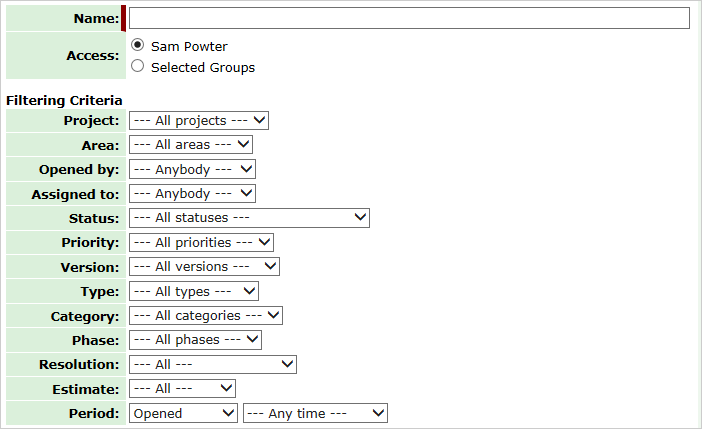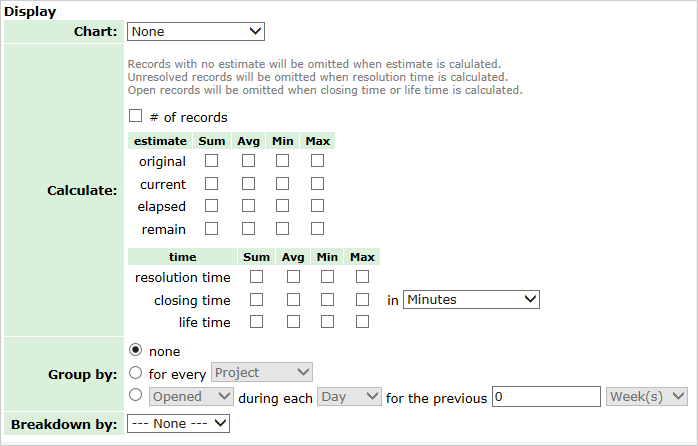Standard Reports
A standard report is defined by the following attributes, specified in the standard report details page while creating or editing a report.
Name – a title that uniquely identifies a report.
Access – use this section to specify the report access. If you create a report only for yourself, select your user name (for example Sam Powter) in the Access field. If the report has to be accessible to one or many user groups, check the Selected Groups option and select such groups.
Filter – use the Filtering Criteria section to specify records to be used to build the report. For example, you can direct the system to select only records with a certain status and/or priority or those opened during the past 7 days. To select records for a specific time period only, select Custom as the second option for Period and specify the dates in the date fields provided.

Display section.
In the Chart area, you can select type of the chart to be added to the report.
In the Calculate area, you can select aggregation functions the system will use to generate a report:
- # of records – the number of bugs (records) in each of the groups;
- estimates – expected bug resolution time: original (original estimate at the time of bug creation), current (the last entered), elapsed (time elapsed), remain (the difference between the current and elapsed);
- time – actual bug lifecycle times: resolution time (from creation till resolving), closing time (from resolving till closing), life time (the sum of the resolution time and the closing time).
To include a figure, select at least one of the available aggregation functions. Don't forget to select at least calculate #of record checkbox; otherwise no output will be generated.
- Sum – to display the time summary;
- Avg – to display the time average (sum divided by the # of records) or an average value in a group;
- Min – to display the smallest value in a group;
- Max – to display the biggest value in a group.
If the Group by field is ‘none’, then the system will display figures for each bug separately, regardless of the function you choose.

In the Group by area, the grouping parameters are specified:
BUGtrack allows to group records by: "Project", "Area", "Priority", "Status", "Assigned To", "Opened By", "Resolved By", "Version", "Type", "Category", "Phase", "Record" and project-specific custom fields.
System also allows to group records by "Day", "Week" or "Month" for "Opened", "Resolved", "Closed" or "Due Date" record date.
By default "None" grouping is used.
You can also specify an additional, second-level grouping parameter in the Breakdown by field.
BUGtrack allows to breakdown grouped records by: "Project", "Area", "Priority", "Status", "Assigned To", "Opened By", "Resolved By", "Version", "Type", "Category", "Phase", "Record" or by project-specific custom fields.
By default "None" breakdown is used.
Use this field to break the first-level groups into smaller ones. This is useful, for instance, when you want to know not only the sum of original estimates for each day but also how much work time was estimated in each active project every day.
Next: Advanced Reports